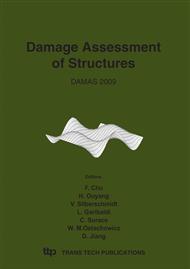p.707
p.717
p.725
p.733
p.741
p.749
p.757
p.767
p.775
Fatigue Damage Evaluation and Retrofit of Steel Orthotropic Bridge Decks
Abstract:
Since the first application of steel orthotropic deck in bridges, engineers have shown great interest in the popularization of steel decks, based on their various advantages like light-weight, high capacity and so on. However, because of their complex configurations, repeated loading, and stress concentration, many details of steel orthotropic bridge decks are fatigue-sensitive. Recently, considerable increase in traffic volume and wheel loads has caused a number of fatigue cracks in steel orthotropic bridge decks in China. For example, bridge engineers have detected thousands of fatigue cracks in steel orthotropic deck on the main box girder of Humen Bridge only ten years after opening to traffic, which is the first modern suspension bridge with the main span of 888 meters in China. So the bridge owners pay more attention to evaluate the locations of fatigue damages. In current paper, the standard section of the real bridge deck was simulated and a kind of typical fatigue cracks was selected to analyze their fatigue life using S-N curve, the fatigue damage analysis was carried out on the longitudinal ribs to deck plate connections. The fatigue damage analysis results were consistent with the observations from real bridge decks.
Info:
Periodical:
Pages:
741-748
Citation:
Online since:
June 2009
Authors:
Keywords:
Price:
Сopyright:
© 2009 Trans Tech Publications Ltd. All Rights Reserved
Share:
Citation:


